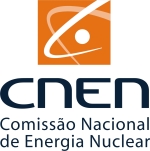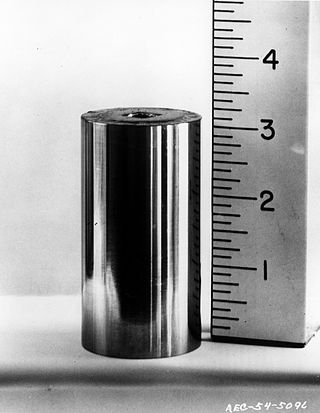Related Research Articles

Food irradiation is the process of exposing food and food packaging to ionizing radiation, such as from gamma rays, x-rays, or electron beams. Food irradiation improves food safety and extends product shelf life (preservation) by effectively destroying organisms responsible for spoilage and foodborne illness, inhibits sprouting or ripening, and is a means of controlling insects and invasive pests.

Radioactive waste is a type of hazardous waste that contains radioactive material. Radioactive waste is a result of many activities, including nuclear medicine, nuclear research, nuclear power generation, nuclear decommissioning, rare-earth mining, and nuclear weapons reprocessing. The storage and disposal of radioactive waste is regulated by government agencies in order to protect human health and the environment.

The United States Atomic Energy Commission (AEC) was an agency of the United States government established after World War II by U.S. Congress to foster and control the peacetime development of atomic science and technology. President Harry S. Truman signed the McMahon/Atomic Energy Act on August 1, 1946, transferring the control of atomic energy from military to civilian hands, effective on January 1, 1947. This shift gave the members of the AEC complete control of the plants, laboratories, equipment, and personnel assembled during the war to produce the atomic bomb.
Nuclear technology is technology that involves the nuclear reactions of atomic nuclei. Among the notable nuclear technologies are nuclear reactors, nuclear medicine and nuclear weapons. It is also used, among other things, in smoke detectors and gun sights.
Ionizing radiation, including nuclear radiation, consists of subatomic particles or electromagnetic waves that have sufficient energy to ionize atoms or molecules by detaching electrons from them. Some particles can travel up to 99% of the speed of light, and the electromagnetic waves are on the high-energy portion of the electromagnetic spectrum.
Radiation protection, also known as radiological protection, is defined by the International Atomic Energy Agency (IAEA) as "The protection of people from harmful effects of exposure to ionizing radiation, and the means for achieving this". Exposure can be from a source of radiation external to the human body or due to internal irradiation caused by the ingestion of radioactive contamination.

A nuclear and radiation accident is defined by the International Atomic Energy Agency (IAEA) as "an event that has led to significant consequences to people, the environment or the facility. Examples include lethal effects to individuals, large radioactivity release to the environment, reactor core melt." The prime example of a "major nuclear accident" is one in which a reactor core is damaged and significant amounts of radioactive isotopes are released, such as in the Chernobyl disaster in 1986 and Fukushima nuclear disaster in 2011.

Radioactive contamination, also called radiological pollution, is the deposition of, or presence of radioactive substances on surfaces or within solids, liquids, or gases, where their presence is unintended or undesirable.

Nuclear safety is defined by the International Atomic Energy Agency (IAEA) as "The achievement of proper operating conditions, prevention of accidents or mitigation of accident consequences, resulting in protection of workers, the public and the environment from undue radiation hazards". The IAEA defines nuclear security as "The prevention and detection of and response to, theft, sabotage, unauthorized access, illegal transfer or other malicious acts involving nuclear materials, other radioactive substances or their associated facilities".

The Atomic Energy Regulatory Board (AERB) was constituted on 15 November 1983 by the President of India by exercising the powers conferred by Section 27 of the Atomic Energy Act, 1962 to carry out certain regulatory and safety functions under the Act. The regulatory authority of AERB is derived from the rules and notifications promulgated under the Atomic Energy Act, 1962 and the Environmental (Protection) Act, 1986. The headquarters is in Mumbai.
In Pacific Gas & Electric Co. v. State Energy Resources Conservation & Development Commission, 461 U.S. 190 (1983), the United States Supreme Court held that a state statute regulating economic aspects of nuclear generating plants was not preempted by the federal Atomic Energy Act of 1954. The case provides a framework that has guided other cases involving preemption of federal authority.

Nuclear Power and the Environment, sometimes simply called the Flowers Report, was released in September 1976 and is the sixth report of the UK Royal Commission on Environmental Pollution, chaired by Sir Brian Flowers. The report was dedicated to "the Queen's most excellent Majesty." "He was appointed "to advise on matters, both national and international, concerning the pollution of the environment; on the adequacy of research in this field; and the future possibilities of danger to the environment." One of the recommendations of the report was that:
"There should be no commitment to a large programme of nuclear fission power until it has been demonstrated beyond reasonable doubt that a method exists to ensure the safe containment of longlived, highly radioactive waste for the indefinite future."

The National Nuclear Energy Commission is the Brazilian government agency responsible for orientation, planning, supervision, and control of the Brazil's nuclear program. The agency was created on 10 October 1956. The CNEN is under the direct control of the Ministry of Science and Technology.
Nuclear law is the law related to the peaceful uses of nuclear science and technology.

Jordan Atomic Energy Commission (JAEC) was established in place of the Jordan Nuclear Energy Commission. The main objective of the JAEC is to promote and develop peaceful utilization of atomic energy.

The nuclear energy policy of the United States began in 1954 and continued with the ongoing building of nuclear power plants, the enactment of numerous pieces of legislation such as the Energy Reorganization Act of 1974, and the implementation of countless policies which have guided the Nuclear Regulatory Commission and the Department of Energy in the regulation and growth of nuclear energy companies. This includes, but is not limited to, regulations of nuclear facilities, waste storage, decommissioning of weapons-grade materials, uranium mining, and funding for nuclear companies, along with an increase in power plant building. Both legislation and bureaucratic regulations of nuclear energy in the United States have been shaped by scientific research, private industries' wishes, and public opinion, which has shifted over time and as a result of different nuclear disasters.

The 'Ghana Atomic Energy Commission (GAEC) is the state organization in Ghana involved with surveillance of the use of nuclear energy in Ghana. It is similar in aim to the Ghana Nuclear Society (GNS), with the difference being that the GNS is a nonprofit organisation, whereas the GAEC is part of the parliament of Ghana. Its primary objectives were set out by the parliament act 588, which involve investigating the use of nuclear energy for Ghana and supporting research and development both in Ghana and abroad.

A radioactive source is a known quantity of a radionuclide which emits ionizing radiation; typically one or more of the radiation types gamma rays, alpha particles, beta particles, and neutron radiation.

The Philippine Nuclear Research Institute (PNRI) is a government agency under the Department of Science and Technology mandated to undertake research and development activities in the peaceful uses of nuclear energy, institute regulations on the said uses, and carry out the enforcement of said regulations to protect the health and safety of radiation workers and the general public.